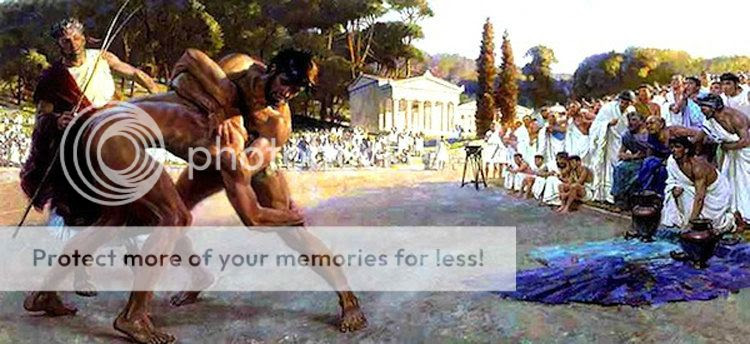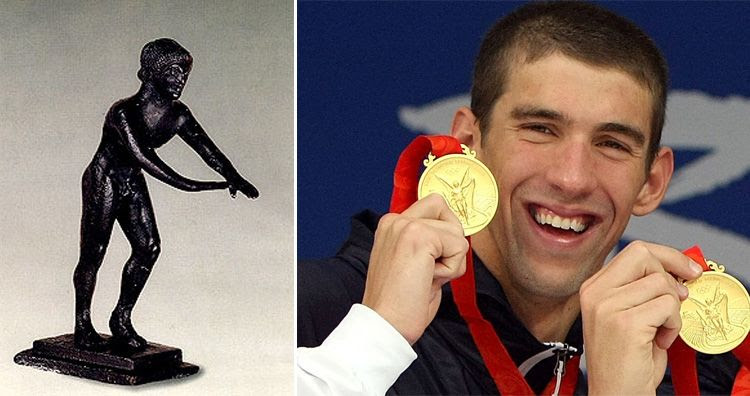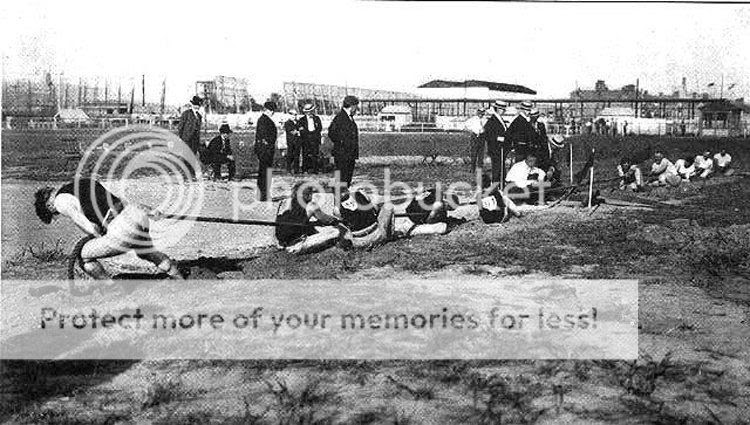20 Rare Historical Facts about Olympic Games That You Never Knew
Since its inception in ancient Greece, the Olympics have come to define the height of athletic achievement. At every Summer and Winter Games, athletes strive to outshine each other, sometimes surpassing expectations. The Olympics are a time of abundant energy, where the competitors passionately strive to bag their medals, while the whole world watches on with bated breath. In this spirit, we have collected some interesting facts about the Olympic Games that you could know while you cheer for your athletes…
1. During the month preceding the ancient Olympics, no wars were permitted, so as to allow the spectators to travel unharmed across Greece.

The modern Olympic Games or Olympics creation was inspired by the ancient Olympic Games, which were held in Olympia, Greece, from the 8th century BC to the 4th century AD. Heralds would be sent to advertise the onset of the Games throughout Greece. According to a sacred truce, no wars could be fought for a month and no obstacles were to fall in the way of spectators. In the subsequent centuries, the period was changed to three months.
2. In ancient Olympics, athletes competed in nude.

3. Michael Phelps tied the record for most individual Olympic titles this year (2016) with Leonidas of Rhodes, an ancient Olympic runner,who won 12 crowns in 2nd century BCE. Leonidas was unmatched in his record until Phelps this year.

Leonidas was a very versatile runner and also had an unsurpassed number of victories during the games. According to Philostratus the Athenian, his versatility made all the theories known so far about runners outdated. Since his time in the 2nd century BCE, nobody ever could beat him, until now. Michael Phelps now holds the record for the same number of individual wins, and has a total of 25 gold medals.(1, 2)
4. Tug-of-war and painting were once Olympic events.

During the early 1900s, tug-of-war had many groups of participants called clubs hailing from different countries, sometimes more than one from the same country to win multiple medals. Though it is not considered an athletic sport now, it used to be part of the Olympic athletics programme. So were art competitions. Not just painting, but architecture, sculpture, literature and music were considered Olympic events.(1, 2)

In 1936, the Olympics were hosted in Berlin. The event organizer, Carl Diem, wanted the event to be linked with ancient Olympics and in a way, reflect the idea that Aryans are a superior race. The relay was heavily covered through film, radio and other media using modern technologies. The relay was also meant to increase pro-Nazi sentiments, as it did in Vienna. The result being, the Germans also invaded countries on the relay route, including Yugoslavia and Czechoslovakia, and sent Hungary gypsies to death camps.
6. Olympic gold medals are only 1% gold and 92.5% silver. They would be worth over $25k if they were pure gold but instead the medal value is only approximately $600.

Solid gold medals were only awarded until 1912 since 1904. The last time they were awarded was during the 1912 Summer Olympics in Stolkholm, Sweden. The silver and bronze medals have similar fate. For the silver medal, the gold is replaced by copper and costs $260. The bronze medal is 97 percent copper and the rest is zinc and tin, valuing just $3.
7. Margaret Abbott, the first female American to win a gold medal, never knew she was an Olympian as long as she was alive. After her death it was discovered that the Golf tournament she participated in was part of a poorly-organized 1900 Olympics.



10. The United States of America is the only country that doesn’t dip its flag during the Olympic opening ceremonies.

11. In the 1972 Olympics, Mark Spitz, a nine-time Olympic swimming champion, jokingly told a Russian coach that his moustache helped him swim faster and deflects water from his mouth. The Russian translated it to other coaches and the next year every swimmer had a moustache.


13. In the 1908 Olympics, pistol dueling was featured as an associate event. The contestants used wax bullets and wore metal helmets for protection.


15. There is a strict rule that the Flame of Olympic torch must be the same flame lit at the start of the relay in Greece. Multiple copies of the original flame are transported in case the relay torch goes out for any reason.

16. In the 1968 Olympics, Bob Beamon’s long jump went beyond the range of the official optical measuring device. The distance had to be measured manually and being unfamiliar with the metric system, he didn’t realize until his coach told him that he had broken the world record by nearly 2 feet.


18. In the 1936 Summer Olympics, Liechtenstein and Haiti competed against each other only to find out that they developed identical national flags independently of each other.



Since its inception in ancient Greece, the Olympics have come to define the height of athletic achievement. At every Summer and Winter Games, athletes strive to outshine each other, sometimes surpassing expectations. The Olympics are a time of abundant energy, where the competitors passionately strive to bag their medals, while the whole world watches on with bated breath. In this spirit, we have collected some interesting facts about the Olympic Games that you could know while you cheer for your athletes…
1. During the month preceding the ancient Olympics, no wars were permitted, so as to allow the spectators to travel unharmed across Greece.

The modern Olympic Games or Olympics creation was inspired by the ancient Olympic Games, which were held in Olympia, Greece, from the 8th century BC to the 4th century AD. Heralds would be sent to advertise the onset of the Games throughout Greece. According to a sacred truce, no wars could be fought for a month and no obstacles were to fall in the way of spectators. In the subsequent centuries, the period was changed to three months.
2. In ancient Olympics, athletes competed in nude.

Though, it is not known exactly why they did that, one story suggests that the
loincloth of a runner once slipped down and he tripped on it. After that all
other runners would remove their loincloths to avoid such accidents. But, nudity
was a fundamental aspect of Greek culture. Good health and strong athletic body
were appreciated and admired. It was also said to be an exhibition of
coming-of-age, when young men would reach their adulthood and would proudly
display their bodies.
3. Michael Phelps tied the record for most individual Olympic titles this year (2016) with Leonidas of Rhodes, an ancient Olympic runner,who won 12 crowns in 2nd century BCE. Leonidas was unmatched in his record until Phelps this year.

Leonidas was a very versatile runner and also had an unsurpassed number of victories during the games. According to Philostratus the Athenian, his versatility made all the theories known so far about runners outdated. Since his time in the 2nd century BCE, nobody ever could beat him, until now. Michael Phelps now holds the record for the same number of individual wins, and has a total of 25 gold medals.(1, 2)
4. Tug-of-war and painting were once Olympic events.

During the early 1900s, tug-of-war had many groups of participants called clubs hailing from different countries, sometimes more than one from the same country to win multiple medals. Though it is not considered an athletic sport now, it used to be part of the Olympic athletics programme. So were art competitions. Not just painting, but architecture, sculpture, literature and music were considered Olympic events.(1, 2)
5.
The tradition of Olympic Torch Relay was first introduced by Nazis as a
political ploy to advertise Third Reich as a modern and economically dynamic
state.

In 1936, the Olympics were hosted in Berlin. The event organizer, Carl Diem, wanted the event to be linked with ancient Olympics and in a way, reflect the idea that Aryans are a superior race. The relay was heavily covered through film, radio and other media using modern technologies. The relay was also meant to increase pro-Nazi sentiments, as it did in Vienna. The result being, the Germans also invaded countries on the relay route, including Yugoslavia and Czechoslovakia, and sent Hungary gypsies to death camps.
6. Olympic gold medals are only 1% gold and 92.5% silver. They would be worth over $25k if they were pure gold but instead the medal value is only approximately $600.

Solid gold medals were only awarded until 1912 since 1904. The last time they were awarded was during the 1912 Summer Olympics in Stolkholm, Sweden. The silver and bronze medals have similar fate. For the silver medal, the gold is replaced by copper and costs $260. The bronze medal is 97 percent copper and the rest is zinc and tin, valuing just $3.
7. Margaret Abbott, the first female American to win a gold medal, never knew she was an Olympian as long as she was alive. After her death it was discovered that the Golf tournament she participated in was part of a poorly-organized 1900 Olympics.

The
1900 Olympics were the first in which women were allowed to participate in
“ladylike” games such as golf, tennis and yachting. The games were organized in
Paris, and were the only Olympic events in which valuable artifacts were give
instead of actual medals. Margaret Abbott received a porcelain bowl for first
place in Golf.
8.
Ancient Olympics had mixed martial arts competitions too, known as Pankration.
It was the only event that wasn’t reinstated after the revival of Olympic Games
in 1896.

The
Pankration included combat techniques from boxing and wrestling such as kicks
and holds, locks and chokes. Except for gouging the eyes and biting the opponent
every other technique was allowed. The term itself literally means “all of
might”. After reinstating the games in the 19th century, the archbishop of Lyon,
Pierre-Hector Coullié, declared that all events, except Pankration, would be
accepted.
9. During 1936 Berlin Olympic games, the Nazis ridiculed the US for relying on “non-human black auxiliaries.” American black athlete Jesse Owens went on to win 4 gold medals and beat a German at Long Jump in front of Hitler. Four years after Owens’ death, a street in Berlin was renamed after him.
9. During 1936 Berlin Olympic games, the Nazis ridiculed the US for relying on “non-human black auxiliaries.” American black athlete Jesse Owens went on to win 4 gold medals and beat a German at Long Jump in front of Hitler. Four years after Owens’ death, a street in Berlin was renamed after him.

Jesse
Owens was a four-time gold medalist and competed in sprinting and long jumps.
Despite his many wins, he received much discrimination in his own country, the
United States. Even the then President F. D. Roosevelt didn’t send him a message
to congratulate him. He was noted for destroying Hitler’s theory on Aryan
supremacy over everyone else.
10. The United States of America is the only country that doesn’t dip its flag during the Olympic opening ceremonies.

During the opening ceremonies, the teams from each participating country briefly
dips their flag as a sign of respect to the host nation, something that the U.
S. refuses to do. Though, the actual reason is unclear, there is a story when it
started in 1908 London Summer Olympics, when an Irish American player refused to
lower the flag to King Edward VII in protest. However, after that, the flag was
dipped by a few countries and not by others. By 1936, they made a decision not
to dip it because the head of state was Hitler. By the end of the Second World
War, it became a tradition for the U. S. teams not to dip the flag.
11. In the 1972 Olympics, Mark Spitz, a nine-time Olympic swimming champion, jokingly told a Russian coach that his moustache helped him swim faster and deflects water from his mouth. The Russian translated it to other coaches and the next year every swimmer had a moustache.

Mark
Spitz’s moustache became very famous when he participated in the Olympics. At a
time when all the swimmers shaved off their body hair, Spitz grew a moustache.
Though he intended to shave it off before the games, he kept it on because he
got many compliments for it. He shaved off it a year later.
12. During the 2000 Olympics in Sydney, 70, 000 condoms were not enough for the athletes, and a second order of 20,000 had to be made. Since then, a standing order of 100,000 condoms were made for every Olympics.
12. During the 2000 Olympics in Sydney, 70, 000 condoms were not enough for the athletes, and a second order of 20,000 had to be made. Since then, a standing order of 100,000 condoms were made for every Olympics.

The
Olympic Villages are known to house around 10,000 athletes for the Summer Games
and around 2,700 for the Winter Games. There is a huge assortment of people from
all over the world, forming new acquaintances and friendships. According to many
previous participants, the village is a melting pot with athletes looking to
relax by engaging in silly or sexual activities after a hard day’s work.
13. In the 1908 Olympics, pistol dueling was featured as an associate event. The contestants used wax bullets and wore metal helmets for protection.

Wax
bullets were used for many purposes, especially by illusionists. When the
bullets were fired from the firearm, they would melt away because of the heat
and the illusionist would trick the audience that he had caught the bullet. In
the early 20th century, people began showing interest in using them for mock
duels, which also became part of the 1908 Olympics. The sport soon lost
popularity and was discontinued.
14. For the 1932 Los Angeles Olympics, because of the Great Depression, the Brazilian athletes had to sell coffee while travelling to fund their trip to the venue.
14. For the 1932 Los Angeles Olympics, because of the Great Depression, the Brazilian athletes had to sell coffee while travelling to fund their trip to the venue.

At
that time, San Pedro authorities charged a dollar per person to disembark at the
Port of Los Angeles. Because of that, the organizers only used athletes who had
a better chance of winning to sell coffee there. A few other athletes got
financed after selling coffee again at San Francisco. The rest of 15 athletes
who couldn’t get financed and authorized, had to stay behind in the ship and
didn’t compete.
15. There is a strict rule that the Flame of Olympic torch must be the same flame lit at the start of the relay in Greece. Multiple copies of the original flame are transported in case the relay torch goes out for any reason.

In
ancient Greece, the Olympic flame was lit using the sun rays concentrated by a
parabolic mirror at the Temple of Hera. The flame stays ablaze throughout the
event. As the modern Olympics are conducted at different venues far away from
Greece, the flame is lit months in advance at the Olympia lighting ceremony and
carried using torches to the venue’s cauldron. There have been many incidents in
which the torches, and once even the cauldron, had gone out. To prevent this,
more than one torch is used.
16. In the 1968 Olympics, Bob Beamon’s long jump went beyond the range of the official optical measuring device. The distance had to be measured manually and being unfamiliar with the metric system, he didn’t realize until his coach told him that he had broken the world record by nearly 2 feet.

Bob
Beamon’s world record was so outstanding that it wasn’t broken for almost 23
years. Mike Powell broke the record by around 5 centimeters at 8.95 meter
record, Beamon’s being 8.90 meters. After his record, the sports jargon had a
new adjective “Beamonesque” added to describe spectacular feats during the
games.
17. The 1964 Olympic champion, Ewa Kłobukowska, who set three world records for sprinting, was banned from competing in professional sports and her records annulled because she failed a gender verification test. A year later, she gave birth to her first child.
17. The 1964 Olympic champion, Ewa Kłobukowska, who set three world records for sprinting, was banned from competing in professional sports and her records annulled because she failed a gender verification test. A year later, she gave birth to her first child.

Ewa
Kłobukowska had a rare genetic anomaly called Barr Body which causes an inactive
X chromosome. Gender verifications were done to ensure that no male imposter
gets to win because of unfair advantage in women’s competitions. The test was
also widely criticized for being only directed at female athletes and the
humiliation it caused them. The incident with Kłobukowska’s tests caused the
International Olympic Committee to change the gender verification policies. From
then on, the test results were kept secret.
18. In the 1936 Summer Olympics, Liechtenstein and Haiti competed against each other only to find out that they developed identical national flags independently of each other.

The
flag of Liechtenstein has two colors, blue and red, in horizontal bands, which
is the same for Haiti. The coat of arms that Haiti uses on its flag is just for
national and military purposes, that meant their flags were as good as the same
at the competition. After the event, Liechtenstein added a crown to its flag.
19. In 1928, Australian sculler Bobby Pearce stopped to let a family of ducks pass that strayed into his lane. Despite that, he won all the competitions in that round with the fastest time.
19. In 1928, Australian sculler Bobby Pearce stopped to let a family of ducks pass that strayed into his lane. Despite that, he won all the competitions in that round with the fastest time.

Henry
Pearce won all the races he participated in easily defeating his first opponent
by 12 lengths and his second by 8 lengths. He went on to defeat all his
opponents, finally winning the gold medal and becoming the first
Australian
to do so. He even broke the record by being 25 seconds faster than the previous
record.
20. During the marathon of the 1904 Olympics, one participant took a lift in a car; the one who finished first took rat poison as a nerve stimulant and almost died; one took ill after eating rotten apples, had to take a nap and yet came fourth; and one was chased for a mile by aggressive dogs.
20. During the marathon of the 1904 Olympics, one participant took a lift in a car; the one who finished first took rat poison as a nerve stimulant and almost died; one took ill after eating rotten apples, had to take a nap and yet came fourth; and one was chased for a mile by aggressive dogs.

To be
fair to the participants, the day was very hot and the marathon was conducted
over uneven roads with dust in the air when horses and automobiles passed. The
participant who took the car after nine miles into the marathon re-entered the
race when the car broke down after 19 miles. He just let the judges think he won
the race, enjoying his practical joke, until they found out at the medal
ceremony. The winner of the marathon, Hicks, had to be supported by his trainers
as he got to the finish line because of the rat poison.
No comments:
Post a Comment